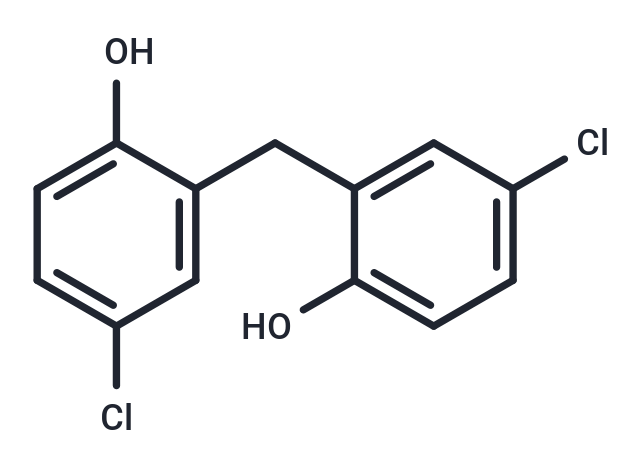Shopping Cart
- Remove All
 Your shopping cart is currently empty
Your shopping cart is currently empty

Dichlorophen (DDM) is a nontoxic laxative vermicide of chlorinated phenol compound. Dichlorophen is used as a veterinary fungicide, anthelmintic, and anti-protozoan, as well as an ingredient in antimicrobial soaps and shampoos. This agent probably acts by increasing the clearing of intestinal contents, thereby eradicating tapeworm infections from the intestines.

| Pack Size | Price | Availability | Quantity |
|---|---|---|---|
| 500 mg | $41 | In Stock | |
| 1 g | $48 | In Stock | |
| 1 mL x 10 mM (in DMSO) | $45 | In Stock |
| Description | Dichlorophen (DDM) is a nontoxic laxative vermicide of chlorinated phenol compound. Dichlorophen is used as a veterinary fungicide, anthelmintic, and anti-protozoan, as well as an ingredient in antimicrobial soaps and shampoos. This agent probably acts by increasing the clearing of intestinal contents, thereby eradicating tapeworm infections from the intestines. |
| Kinase Assay | Effect of inhibition of Acetaminophen on COX-1 and COX-2 activity in human whole blood: For COX-1 assay, aliquots of human whole blood drawn from healthy volunteers without anticoagulant are transferred to glass tubes containing Acetaminophen or DMSO, serum is separated by centrifugation after clotting, and serum TxB2 levels are determined. For COX-2 assay, aliquots of heparinized whole blood are incubated with LPS (10 μg/mL) and aspirin (10 μg/mL), plus Acetaminophen or DMSO for 24 hours at 37 °C, plasma is separated by centrifugation, and PGE2 levels are determined subsequently. The degree of COX-1 or COX-2 inhibition is calculated as the percentage change of plasma eicosanoid (TxB2 for COX-1 and PGE2 for COX-2).Concentration response curves are fitted by a sigmoidal regression with variable slope for both enzymatic assays, and the 50% inhibitory concentration (IC50) values are derived by using of PRISM Version 3.0. |
| Alias | Dichlorophene, DDM |
| Molecular Weight | 269.12 |
| Formula | C13H10Cl2O2 |
| Cas No. | 97-23-4 |
| Smiles | Oc1ccc(Cl)cc1Cc1cc(Cl)ccc1O |
| Relative Density. | 1.3239 g/cm3 (Estimated) |
| Storage | Powder: -20°C for 3 years | In solvent: -80°C for 1 year | Shipping with blue ice. | |||||||||||||||||||||||||||||||||||
| Solubility Information | DMSO: 45 mg/mL (167.21 mM), Sonication is recommended. | |||||||||||||||||||||||||||||||||||
Solution Preparation Table | ||||||||||||||||||||||||||||||||||||
DMSO
| ||||||||||||||||||||||||||||||||||||

Copyright © 2015-2025 TargetMol Chemicals Inc. All Rights Reserved.